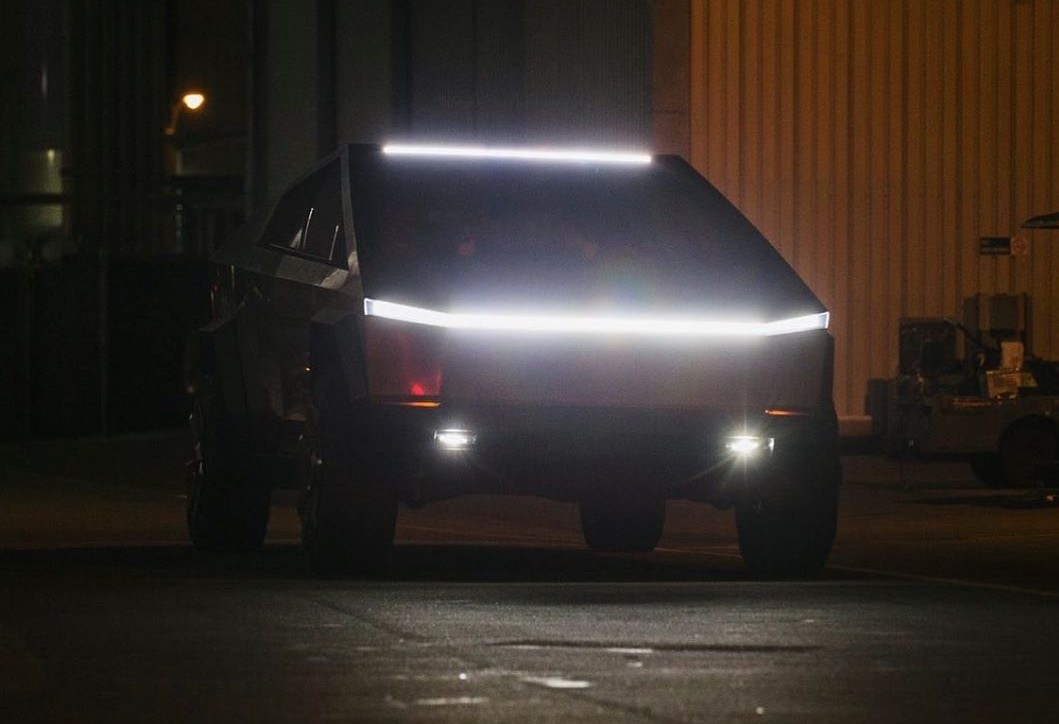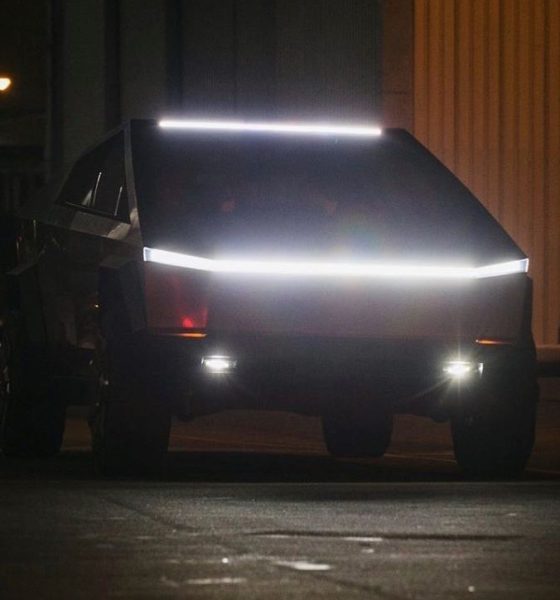

News
Tesla Cybertruck is perfect for Elon Musk’s dream HVAC system
Tesla CEO Elon Musk teased the idea of integrating its upcoming Cybertruck with a quiet and efficient HVAC system that’s also capable of distilling water. And while water distillation from a utility vehicle may seem overkill, it makes perfect sense to include such a feature in the futuristic stainless steel behemoth.
The idea became apparent during a conversation with Joe Rogan nearly two years ago, but the idea has since gained more traction. In a tweet that reiterated his desire for a “super-efficient, quiet home HVAC with HEPA & water distillation,” one of the CEO’s Twitter followers asked if he was more interested in developing the system than working on the Cybertruck. However, Musk answered by saying, “Maybe Cybertruck will have it…”
When Musk appeared on the Joe Rogan Experience Podcast in September 2018, he spoke of an intelligent home HVAC system that would only cool rooms that have people in them. This idea would increase efficiency and eliminate wasted energy throughout a home. However, it would seem that the Cybertruck may receive something along the same lines.
I’m dying to do super efficient, quiet home HVAC with HEPA & water distillation. It’s weird, but I really want to do it.
— Elon Musk (@elonmusk) April 23, 2020
Maybe Cybertruck will have it …
— Elon Musk (@elonmusk) April 23, 2020
Having an energy-efficient HVAC system bodes well for the Tesla Cybertruck, which aims to have long-range capabilities at an affordable price point. Also, considering the vehicle’s spacious interior cabin, having an efficient heating and cooling system would reduce range-robbing energy on something as large as the Cybertruck.
The Cybertruck will likely be Tesla’s most significant vehicle to date, leaving no doubt that the powerhouse truck can accommodate a HEPA filter. The installation of this filter keeps air quality within the cabin of the vehicle extremely high. Tesla’s “Bioweapon Defense Mode,” which the company developed to protect passengers from the dangers of environmental pollution, would also be a perfect fit for the upcoming vehicle.
But Musk’s vision for the Cybertruck goes far beyond the third rock from the sun. Perhaps its purpose is geared towards life on Mars, just as much as it is for Earth.
Musk’s narratives in the past have playfully hinted at survival during cataclysmic events, with the CEO emphasizing that Teslas run off of sunlight, which will be available for far longer than fossil fuels. But Elon’s playful jokes could be a hint at something more serious, like the inevitable destruction of Earth if pollution-producing forms of energy continue to be used as fuel.
The Cybertruck’s exoskeleton and robust stainless steel body actually make it ideal for a dangerous future. The pickup’s already durable build combined with range, speed, and sustainability could be a difference-maker for passengers even in otherwise risky events. An intelligent HVAC unit, an air filtration system, and a water distillation feature just makes the all-electric pickup an even better survival tool.
Tesla Cybertruck (pressurized edition) will be official truck of Mars
— Elon Musk (@elonmusk) November 21, 2019
But Musk seems to believe each of these items could be added onto the Cybertruck, allowing it to operate anywhere, even if the location isn’t on Earth. After all, he did say the Cybertruck’s “pressurized edition” would be the official truck of Mars.
Perhaps the Cybertruck, when paired with Bioweapon Defense Mode, an HVAC unit, and a water distillation feature, could be one of the vehicles of choice for people when things on Earth start going south due to the climate crisis.
Protecting the passengers in the car has always been a goal of Tesla, but the purpose goes much further than accident and collision safety. Musk has made several attempts to improve the air purification systems within the cars, for example, an aspect of safety that is rarely explored by traditional automakers. “Air quality has a much bigger effect on health than people realize,” he said.
The Cybertruck’s mission is likely to protect people from accidents and dirty air. The vehicle’s future could be a large part of Musk’s “Master Plan,” which entails a push towards sustainability. But beyond Earth, the priorities of Tesla will still apply. On Mars, people will surely need clean air, protection from harmful rays, and a water source. The Cybertruck just happens to be a great vehicle to provide all that, and more.

Elon Musk
Elon Musk and Tesla AI Director share insights after empty driver seat Robotaxi rides
The executives’ unoccupied tests hint at the rapid progress of Tesla’s unsupervised Robotaxi efforts.

Tesla CEO Elon Musk and AI Director Ashok Elluswamy celebrated Christmas Eve by sharing personal experiences with Robotaxi vehicles that had no safety monitor or occupant in the driver’s seat. Musk described the system’s “perfect driving” around Austin, while Elluswamy posted video from the back seat, calling it “an amazing experience.”
The executives’ unoccupied tests hint at the rapid progress of Tesla’s unsupervised Robotaxi efforts.
Elon and Ashok’s firsthand Robotaxi insights
Prior to Musk and the Tesla AI Director’s posts, sightings of unmanned Teslas navigating public roads were widely shared on social media. One such vehicle was spotted in Austin, Texas, which Elon Musk acknowleged by stating that “Testing is underway with no occupants in the car.”
Based on his Christmas Eve post, Musk seemed to have tested an unmanned Tesla himself. “A Tesla with no safety monitor in the car and me sitting in the passenger seat took me all around Austin on Sunday with perfect driving,” Musk wrote in his post.
Elluswamy responded with a 2-minute video showing himself in the rear of an unmanned Tesla. The video featured the vehicle’s empty front seats, as well as its smooth handling through real-world traffic. He captioned his video with the words, “It’s an amazing experience!”
Towards Unsupervised operations
During an xAI Hackathon earlier this month, Elon Musk mentioned that Tesla owed be removing Safety Monitors from its Robotaxis in Austin in just three weeks. “Unsupervised is pretty much solved at this point. So there will be Tesla Robotaxis operating in Austin with no one in them. Not even anyone in the passenger seat in about three weeks,” he said. Musk echoed similar estimates at the 2025 Annual Shareholder Meeting and the Q3 2025 earnings call.
Considering the insights that were posted Musk and Elluswamy, it does appear that Tesla is working hard towards operating its Robotaxis with no safety monitors. This is quite impressive considering that the service was launched just earlier this year.
Elon Musk
Starlink passes 9 million active customers just weeks after hitting 8 million
The milestone highlights the accelerating growth of Starlink, which has now been adding over 20,000 new users per day.

SpaceX’s Starlink satellite internet service has continued its rapid global expansion, surpassing 9 million active customers just weeks after crossing the 8 million mark.
The milestone highlights the accelerating growth of Starlink, which has now been adding over 20,000 new users per day.
9 million customers
In a post on X, SpaceX stated that Starlink now serves over 9 million active users across 155 countries, territories, and markets. The company reached 8 million customers in early November, meaning it added roughly 1 million subscribers in under seven weeks, or about 21,275 new users on average per day.
“Starlink is connecting more than 9M active customers with high-speed internet across 155 countries, territories, and many other markets,” Starlink wrote in a post on its official X account. SpaceX President Gwynne Shotwell also celebrated the milestone on X. “A huge thank you to all of our customers and congrats to the Starlink team for such an incredible product,” she wrote.
That growth rate reflects both rising demand for broadband in underserved regions and Starlink’s expanding satellite constellation, which now includes more than 9,000 low-Earth-orbit satellites designed to deliver high-speed, low-latency internet worldwide.
Starlink’s momentum
Starlink’s momentum has been building up. SpaceX reported 4.6 million Starlink customers in December 2024, followed by 7 million by August 2025, and 8 million customers in November. Independent data also suggests Starlink usage is rising sharply, with Cloudflare reporting that global web traffic from Starlink users more than doubled in 2025, as noted in an Insider report.
Starlink’s momentum is increasingly tied to SpaceX’s broader financial outlook. Elon Musk has said the satellite network is “by far” the company’s largest revenue driver, and reports suggest SpaceX may be positioning itself for an initial public offering as soon as next year, with valuations estimated as high as $1.5 trillion. Musk has also suggested in the past that Starlink could have its own IPO in the future.
News
NVIDIA Director of Robotics: Tesla FSD v14 is the first AI to pass the “Physical Turing Test”
After testing FSD v14, Fan stated that his experience with FSD felt magical at first, but it soon started to feel like a routine.

NVIDIA Director of Robotics Jim Fan has praised Tesla’s Full Self-Driving (Supervised) v14 as the first AI to pass what he described as a “Physical Turing Test.”
After testing FSD v14, Fan stated that his experience with FSD felt magical at first, but it soon started to feel like a routine. And just like smartphones today, removing it now would “actively hurt.”
Jim Fan’s hands-on FSD v14 impressions
Fan, a leading researcher in embodied AI who is currently solving Physical AI at NVIDIA and spearheading the company’s Project GR00T initiative, noted that he actually was late to the Tesla game. He was, however, one of the first to try out FSD v14.
“I was very late to own a Tesla but among the earliest to try out FSD v14. It’s perhaps the first time I experience an AI that passes the Physical Turing Test: after a long day at work, you press a button, lay back, and couldn’t tell if a neural net or a human drove you home,” Fan wrote in a post on X.
Fan added: “Despite knowing exactly how robot learning works, I still find it magical watching the steering wheel turn by itself. First it feels surreal, next it becomes routine. Then, like the smartphone, taking it away actively hurts. This is how humanity gets rewired and glued to god-like technologies.”
The Physical Turing Test
The original Turing Test was conceived by Alan Turing in 1950, and it was aimed at determining if a machine could exhibit behavior that is equivalent to or indistinguishable from a human. By focusing on text-based conversations, the original Turing Test set a high bar for natural language processing and machine learning.
This test has been passed by today’s large language models. However, the capability to converse in a humanlike manner is a completely different challenge from performing real-world problem-solving or physical interactions. Thus, Fan introduced the Physical Turing Test, which challenges AI systems to demonstrate intelligence through physical actions.
Based on Fan’s comments, Tesla has demonstrated these intelligent physical actions with FSD v14. Elon Musk agreed with the NVIDIA executive, stating in a post on X that with FSD v14, “you can sense the sentience maturing.” Musk also praised Tesla AI, calling it the best “real-world AI” today.








